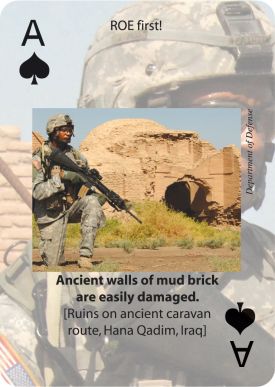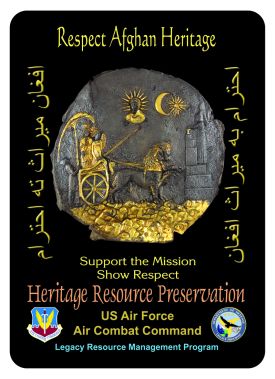War has its casualties, and for centuries combat zones have stacked the cards against cultural heritage preservation.
But a novel project by CSU’s Center for Environmental Management of Military Lands (CEMML) to raise awareness among troops of the cultural heritage of regions where they are serving is gaining new popularity with help from George Clooney.
52 chances to get a message across
 In collaboration with the Combatant Command Cultural Heritage Action Group (CCHAG) and DoD archaeologist Laurie Rush, CEMML developed a unique deck of playing cards that feature information and photos about culturally rich sites and historic artifacts in combat zones. The playing cards were developed in 2006, and have been distributed to deployed U.S. soldiers over the past eight years to provide both entertainment and subtle education about the significance of protecting cultural heritage.
In collaboration with the Combatant Command Cultural Heritage Action Group (CCHAG) and DoD archaeologist Laurie Rush, CEMML developed a unique deck of playing cards that feature information and photos about culturally rich sites and historic artifacts in combat zones. The playing cards were developed in 2006, and have been distributed to deployed U.S. soldiers over the past eight years to provide both entertainment and subtle education about the significance of protecting cultural heritage.
With the release of the 2014 movie The Monuments Men – a movie featuring George Clooney about a World War II military unit tasked with recovering artistic masterpieces from Nazi thieves – CEMML has seen a resurgence of interest in the Heritage Resource Preservation playing cards. The cards were featured in Wired and Time Magazine, and calls for orders have been increasing from both military installations and civilians.
Global reputation
CEMML is a research and service unit and center of excellence within the Warner College of Natural Resources at Colorado State University, and has built a global reputation as the leading provider of cultural and natural resource management services on federal lands.
Currently, there are three decks of Heritage Resource Preservation playing cards representing Iraq, Afghanistan, and Egypt. Each card offers tips that are tailored to each country and themed by suit. Diamonds are for cultural artifacts and national treasures, spades are for historic sites and archeological digs, hearts are for winnings hearts and minds, and clubs are for heritage preservation. Design and layout of the card decks was carried out by CEMML graphic designer Tracy Wager.
Written at the top of each card are the words “ROE First,” which reminds the soldiers that the military’s Rules of Engagement should precede all other considerations.
Why is cultural heritage protection important in times of war?
 U.S. attention to cultural heritage preservation in combat zones heightened with the invasion of Iraq in 2003. During the invasion, the ancient site of Babylon was accidentally damaged and the Iraq museum in downtown Baghdad was looted by citizens – resulting in negative press and international relations for the U.S. military who were blamed for the incidents.
U.S. attention to cultural heritage preservation in combat zones heightened with the invasion of Iraq in 2003. During the invasion, the ancient site of Babylon was accidentally damaged and the Iraq museum in downtown Baghdad was looted by citizens – resulting in negative press and international relations for the U.S. military who were blamed for the incidents.
Following World War II, the 1954 Hague Convention created rules to protect cultural property in the event of armed conflict. The United States signed this international treaty in 2009, making the protection of cultural property during war an obligation, as well as a duty, for the country.
“To quote the movie ‘It is the exact reason we are fighting. For culture. For a way of life,’”said James Zeidler, a senior research scholar and associate director of cultural resource management for CEMML “With just a little forethought and planning, we can avoid the unintentional destruction of important artifacts and cultural heritage sites – and that is invaluable in aiding foreign affairs and cultural diplomacy.”
Improving military education
Zeidler led the CEMML project to develop the cards as a tool for soldier outreach and has been working to improve military education and training about historic sites around the world. He is also the co-editor of a series of books on this topic including the latest, Cultural Heritage in the Crosshairs: Protecting Cultural Heritage during Conflict (2013), and co-founder of The Combatant Command Cultural Heritage Action Group (CCHAG) which enhances military capacity by promoting Cultural Property Protection during full spectrum operations anywhere in the world.
The playing cards and CCHAG are components of a comprehensive project aimed at educating, training and spreading awareness of cultural heritage protection. CCHAG has a web portal that provides multiple resources, training tools, and support services that help enhance cultural awareness at all levels of the U.S military. This web portal features curricula that provide training on how to teach and promote cultural awareness in the military, country-specific websites that provide background on the unique cultural heritage of individual countries, and training aids like the playing cards and soldier pocket cards that provide tips for soldiers on how to avoid damaging culturally rich sites in combat zones.